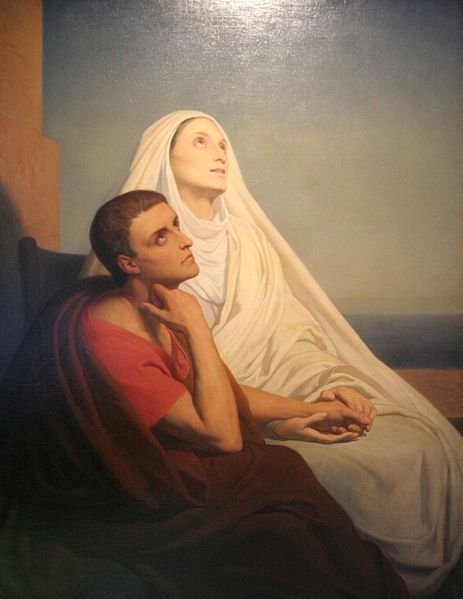Moses, Carlo Dolci, painted 1640-45
Readings (New American Bible: Philippines, USA)
Gospel Mark 1:21-28 (Jerusalem Bible: Australia, England & Wales, India [optional], Ireland, New Zealand, Pakistan, Scotland, South Africa)
Jesus and his followers went as far as Capernaum, and as soon as the sabbath came Jesus went to the synagogue and began to teach. And his teaching made a deep impression on them because, unlike the scribes, he taught them with authority.
In their synagogue just then there was a man possessed by an unclean spirit, and it shouted, ‘What do you want with us, Jesus of Nazareth? Have you come to destroy us? I know who you are: the Holy One of God.’ But Jesus said sharply, ‘Be quiet! Come out of him!’ And the unclean spirit threw the man into convulsions and with a loud cry went out of him. The people were so astonished that they started asking each other what it all meant. ‘Here is a teaching that is new’ they said ‘and with authority behind it: he gives orders even to unclean spirits and they obey him.’ And his reputation rapidly spread everywhere, through all the surrounding Galilean countryside.
An Soiscéal Marcas 1:21-28 (Gaeilge, Irish)
When I was 16 I joined Fórsa Cosanta Áitiúil (Local Defence Force), part of the Irish Army Reserve (cap badge above). Membership was voluntary. We trained on Sundays and there was a two-week summer camp. However, I didn’t stay in it long enough to experience that.
I remember two individuals very clearly, not by name but by rank. One was a corporal and the other a sergeant. The corporal took delight in shouting and swearing at everyone. He was in his early 20s and we mostly between 16 and 18. We did what he told us to do. But none of us had any respect for him.
The sergeant, also in his early 20s, while strict, never shouted at us and the strongest word he ever used was ‘damn’. While in its fullest meaning this really is a curse, usage over the centuries has made it a very mild expression, with hardly any connection to its dictionary definition. We did what the sergeant told us to do, and with genuine respect for him. He respected us and because of that his authority came primarily from his person, not from his rank.
I am always struck by the way St Mark highlights the authority Jesus had. It wasn’t from any position he held but from the Truth that he is. He tells us in St John’s Gospel that he is ‘the way, the truth and the life’. The people recognised this: his teaching made a deep impression on them because, unlike the scribes, he taught them with authority; ‘Here is a teaching that is new’ they said ‘and with authority behind it: he gives orders even to unclean spirits and they obey him.’
I remember our rector in the seminary, Fr Joseph Flynn, once saying to us, ‘Let us at least be hypocrites’. What he meant was that if we fall short of what we believe and profess, and know that we are falling short and ask God’s forgiveness, we will still have something of the authority of Jesus himself. The tax collector who prayed in the Temple, ‘Lord, have mercy on me a sinner’, still carries authority whereas the hypocritical Pharisee doesn’t.
Yesterday I had an email from a recovering alcoholic who told me he ‘went into a blank space’ when he learned of the death of a priest who had also been a recovering alcoholic. This priest had been very close to him during the first years of his recovery. I know that the priest had occasional lapses but sought the help of others in AA when he did. That’s what gave him the authority he had with fellow 'strugglers'.
Some saints, such as St Thérèse of Lisieux (above, aged 15), carry the authority of the purity of their lives. Some, like St Augustine of Hippo, carry the authority of a person who has, with God’s grace, overcome a life of sin. Moses, who speaks to us in the first reading today, carries the authority of a great leader who acknowledged his own impatience and who accepted the consequence of this, that he would lead his people to the Promised Land, see it, but never enter it himself.
St Augustine and St Monica, by Ary Scheffer (painted 1846)
San am sin chuaigh Íosa isteach i gCafarnáum. Agus lá na sabóide féin, ar dhul isteach satsionagóg dó, thosaigh sé ag teagasc.Agus bhí ionadh orthu faoina theagasc; á dteagasc a bhí sé mar dhuine a mbeadh údarás aige, níorbh ionann agus na scríobhaithe.
Bhí, san am sin, duine sa tsionagóg a raibh smacht ag spiorad míghlan air, agus scread sé amach: “Há, cad ab áil leat dínn, a Íosa Nazairéanaigh? Chun ár millte a tháinig tú. Is eol dom cé hé thú: Naomh Dé.” Labhair Íosa leis go bagrach: “Bí i do thost, agus gabh amach as.” Bhain an spiorad míghlan rachtaí as an duine, ghlaoigh amach go hard agus d’imigh as. Agus bhí alltacht chomh mór sin ar chách go raibh siad ag fiafraí dá chéile: “Cad é an rud é seo?” deiridís: “teagasc nua á dhéanamh le húdarás; na spioraid mhíghlana féin, fógraíonn sé orthu agus déanann siad rud air.” Agus níorbh fhada gur leath a chlú go fada gearr ar fud cheantar uile na Gailíle.




No comments:
Post a Comment